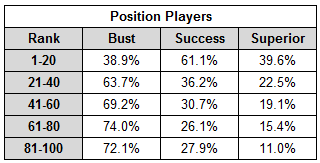Just some quick very rough math from the article cited above which further separates out position player prospects from pitchers :
Moncada is currently listed by several as the #9 or 10 prospect
So using the above average of the top 20 and using the WAR midpoint in McKinney's article
.39 x 1.0 ave WAR (0-1.5) = .39
.21 x 2.0 ave WAR (1.5 - 2.5) = .42
.40 x 3.7 ave WAR (2.5 - 4.5+) = 1.48
Expected average WAR for top 20 prospect = 2.29
2.29 x 6 team controlled years = 13.74 total WAR
13.74 x 6.5 M/WAR = 89.3 million in expected value.
OK - plenty of estimations in that number and it is no way meant to represent a true figure. However, I am sure the RS modeled the scenarios to figure out the expected value much more accurately. Also left out is salary inflation and WAR value inflation as well as the present day value of money..
So 63M cost + ~1.8M total for 3 pre-arb years + arb awards to a 2+ WAR player of a very approximate 2M + 4M + 6M = 77M
So on average with very rough estimates, if Moncada is truly a top 20 prospect he is projected to have a positive net worth of about 12M. This probably underestimates the value, since the salary for luxury tax purposes is a small fraction of the expense. Meaning if the entire 77M cost over 6 years was salary, it would contribute significantly to sending the RS over the cap. Whereas in reality a 2 WAR player in his 1st 6 team-controlled years helps a team stay under the cap.
So the gamble at least on the surface seems to be a good one, but certainly is not a slam dunk. The gamble is much better for teams that tend to be near or over the luxury tax threshold than for teams that are safely below the threshold.




